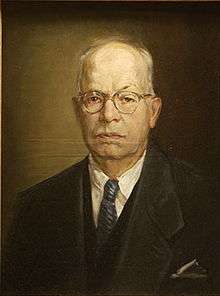Charles Rufus Morey
| Charles Rufus Morey | |
|---|---|
 | |
| Born |
1877 Hastings, Michigan, United States |
| Died |
1955 Princeton, New Jersey, United States |
| Nationality | American |
| Occupation | Art historian, lecturer, librarian |
Charles Rufus Morey (1877–1955) was an American art historian and professor and chairman of the Department of Art and Archaeology at Princeton University from 1924 to 1945. He is best known for his expertise in medieval art and his Index of Christian Art. He was one of the founders of the College Art Association.
Biography
Born in Hastings, Michigan in 1877, Morey graduated from the University of Michigan in 1899. After receiving a Master's Degree there in Classics he went on to study for three years at the American School of Classical Studies in Rome, publishing his first article, "The Christian Sarcophagus in S. Maria Antiqua" in 1905.[1]
Morey became an instructor in classics at Princeton University in 1903, but on a colleague request, namely Allan Marquand, he switched to the Department of Art and Archaeology, in which he began a career of 39 years in art history.[1] Upon Marquand's death in 1924, Morey assumed his position as chairman of this department at Princeton University. Medieval iconography was a major topic of interest to Morey, leading him to draw up an image collection in 1917 of late antique, early Christian-era,medieval works of art, a collection which would blossom into a cataloged collection of photographs known as the Index of Christian Art.[1] Considered to be "indebted to photography", Morey's stance on the process of iconographic analysis and Index of Christian Art has been attributed by scholars as contributing substantially to the formulation of Erwin Panofsky’s methodology of subject analysis.[2] In 1929 Morey began cataloging the collection of the Museo Cristiano, part of the Vatican library. During his lifetime he made many trips back and forth to Rome to develop collections in the Vatican and established the Antioch archaeological excavation of Daphne.[1] Morey was noted for his work in helping establish various libraries and indexing image systems. In 1932 he published a pamphlet on scholarly library planning, named the "Laboratory-Library,".[1] In 1938 Morey was named Marquand Chair of Art and Archaeology.
Following the end of World War II, Morey resigned at Princeton and became the first Cultural Attaché to the American Embassy in Rome.[1] Morey was the acting director of the American Academy from 1945-1947. Morey also helped establish the College Art Association in 1911 and its primary publication, The Art Bulletin.[3]
Publications

During his career as an art historian, Morey published many notable papers and manuscripts related to Early and medieval Christian art. These include East Christian paintings in the Freer collection (1914), Lost mosaics and frescoes of Rome of the mediaeval period (1915), The American society for the excavation of Sardis (1924), Roman and Christian sculpture (1924), Studies in the late antique undertaken in the School of Classical Studies of the American Academy of Rome, 1925-1926. (1927), The Gospel book of Landevennec (the Harkness Gospels) in the New York Public Library (1931), Christian art (1935), The mosaics of Antioch (1938), Early Christian art (1942), Mediaeval art (1942), Christian art (1958), The gold-glass collection of the Vatican Library (1959).[4]
Death and legacy
He died in 1955 in Princeton, New Jersey. German-Jewish art historian Erwin Panofsky said of Morey; "No one can number those who . . . owed to him their place in the world, their scale of values, their sense of direction in life. No one who knew him can forget the brief, warm smile that could suddenly illumine his strong, often stern-looking face and give confidence to the timid and courage to the troubled."[3]
The Charles Rufus Morey Book Award was established in honor of Morey's name by the College Art Association. This award honors distinguished literature in the history of art annually September 1 to August 31.[5]
References
- 1 2 3 4 5 6 "Morey, Charles Rufus". Dictionary of Art Historians. Retrieved March 11, 2009.
- ↑ "Sourcing the Index: Iconography and its Debt to Photography". Princeton University. Retrieved March 11, 2009.
- 1 2 "Morey, Charles Rufus". Princeton University. Retrieved March 11, 2009.
- ↑ "Charles Rufus Morey". Open Library. Retrieved March 11, 2009.
- ↑ "Charles Rufus Morey Book Award". College Art Association. Retrieved March 11, 2009.
External links
- Index of Christian Art at Princeton University
- Biography at Princeton University
- Article on Morey's Index of Christian Art
- Papers